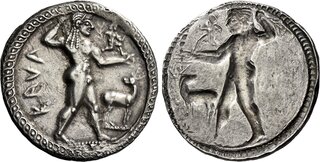Lot description:
Bruttium, Caulonia.
Nomos circa 525-500, AR 31mm, 7.84 g. ΚΑVΛ Apollo, diademed, walking r., holding laurel branch in upraised r. hand and small daimon running r. in outstretched l.; in r. field, stag on platform, with head reverted. Rev. The same type incuse l. without legend. Noe, Caulonia Group A.2j and r (this coin, erroneously listed twice). SNG ANS 141 (these dies). SNG Lloyd 572 (these dies). Historia Numorum Italy 2035.
Rare. Struck on a very fresh metal and with a superb iridescent tone. Extremely fine
Ex Egger 26 November 1909, Lestranges, 68; Sotheby, Wilkinson & Hodge 20 July 1914, Schlesinger Y. Guzman, 27; Glendining's 10 December 1986, Knoepke, 50; NFA XX, 1988, 616 and NAC 114, 2019, 26 sales.
The origins of Caulonia are relatively obscure. It is usually described as a foundation of Croton, yet it may have been an independent city since its citizens preserved the name of its oecist (founder), Typhon of Aigion. Its residents, which numbered perhaps 10,000 at its height, were industrious despite having control over a relatively small territory. Their defensive walls were as much as 18 feet thick in some areas, and were unique in southern Italy as they were constructed mostly of loose river stones that had been cemented together. Though Caulonia was the last of the Achaean colonies on the Ionian coast to strike coins, production must have begun fairly soon after the city achieved some level of prosperity, as few archaeological remains at the site pre-date the middle of the 6th Century B.C. Robinson suggests that the high output at this relatively unimportant city might be explained by the lack of early coinage at its wealthier neighbour Locris. The design of the early nomoi of Caulonia has attracted various interpretations, many of which were reviewed by Barclay Head. He saw the main figure as the mythical founder of Caulonia, who held a leaf from the plant κανλüς as a punning allusion to the city name. Most scholars of the modern era prefer to see the figure as Apollo. The running figure in his hand – whose feet are winged on some examples – may be a wind god, perhaps Zephyrus, but he is almost always described as a genius or a daimon, a deity of a lower order which served the higher gods. Perhaps the most attractive explanation for the design is that the figure, Apollo, holds a laurel branch from the Vale of Tempe in Thessaly, and that the small figure is a daimon fulfilling the role of his messenger. If so, it would illustrate the story of how Apollo, after killing the serpent Python at Delphi, exiled himself for seven years of menial labour as penance for his murder; at the end of this period Apollo purified himself in the sacred grove of bay-trees. Specifically, the type would represent his return to Delphi, announced by the daimon-messenger, where he assumed his oracular duties on behalf of Zeus. It is unfortunate that the stag defies explanation since it is an integral part of the design on the earliest coins, and it subsequently became the standard reverse type.
Estimate: 15000 CHF |  |